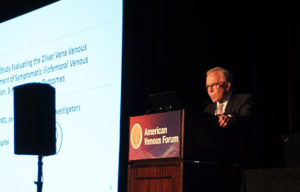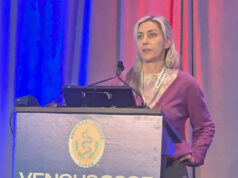
Venous stenting was a hot topic on the agenda of the recent American Venous Forum (AVF) annual meeting, held this year Feb. 23–26 in Orlando, Florida. Catching the audience’s attention, researchers highlighted a head-to-head study of dedicated versus non-dedicated stents, as well as new subgroup data on the Zilver Vena (Cook Medical) venous self-expanding stent.
“Iliofemoral venous obstruction when not adequately treated results in chronic debilitating disease and poor quality of life,” said Lillian Tran, MD, of the department of surgery at the University of Pittsburgh Medical Center, Pittsburgh, Pennsylvania, who noted that deep venous stenting is “increasingly preferred” as the mainstay treatment over medical therapy alone.
According to Tran, this move towards stenting necessitates studies comparing the performance of novel, dedicated venous stents with the more traditional, non-dedicated stents. At AVF, Tran reported the findings of such a head-to-head study at a single center, detailing that the use of dedicated venous stents was associated with a significant reduction in extension into the inferior vena cava (IVC) without reduced early patency rates compared to non-dedicated stents.
The presenter stressed that outcomes after iliac vein stenting rely on multiple technical considerations and stent attributes. “In addition to adequate sizing and consistency in deployment, […] venous stents must establish a balance between radial force, flexibility and crush resistance,” she informed the audience. Tran detailed that dedicated, nitinol-based stents have been developed to meet these requirements and are now on the market in the U.S. and Europe. Four of these stents have been approved by the Food and Drug Administration (FDA) for venous indications, the presenter relayed, noting, however, the fact that the Vici (Boston Scientific) and Venovo (BD) stents were recalled last year.
Outcomes data from investigational device exemption (IDE) trials of the four dedicated venous stents have demonstrated excellent patency rates, Tran communicated. However, she highlighted that head-to-head, comparative performance data against the more traditional Wallstent (Boston Scientific) and other non-dedicated stents are limited.
Tran et al therefore performed a retrospective review of all patients who underwent iliofemoral venous stenting for acute thrombotic, post-thrombotic and non-thrombotic indications at their institution between 2014 and 2021, grouping patients based on the use of novel, dedicated venous stents versus non-dedicated stents during their treatment.
The team measured 30-day stent failure and one-year patency rates as primary outcomes, Tran detailed, adding that secondary outcomes included stent sizing and extension.
A total of 135 patients (186 limbs) were treated in the study, Tran told AVF attendees, specifying that 63 limbs were treated using novel dedicated stents, while 123 were treated using the traditional Wallstent or another non-dedicated stent.
The team noted no preference in stent type in treating acute thrombotic or post-thrombotic lesions at their institution, but they did observe that dedicated venous stents were more likely to be used in non-thrombotic lesions.
Addressing the AVF audience, Tran reported that fewer stents were deployed per limb with the use of novel dedicated venous stents. In addition, she revealed that one patient had a stent fracture without thrombosis, and that there were no cases of deployment failure or stent migration in either group.
Additionally, larger size was observed in limbs using the Wallstent alone compared to dedicated venous stents and proximal stent extension into the IVC greater than 50% was significantly reduced with the use of novel venous stents compared to the non-dedicated devices, Tran detailed.
The presenter relayed some further key outcomes from the study: “Overall, dedicated venous stent use was not significantly associated with differences in early stent patency rates, nor was it a predictor of 30-day stent failure using a logistic regression analysis.”
In addition, she reported that primary patency rates remain comparable between novel venous stents and non-dedicated stents at one year. On subgroup analysis, the researchers did not see any differences between the non-dedicated and dedicated stents in either 30-day or one-year stent patency rates.
Tran acknowledged some limitations of the group’s study, including its retrospective nature, small sample size, short follow-up and no concurrent measurement of clinical improvement.
“In our experience, we found a significant reduction in extension into the IVC, total number of stents deployed and mean stent diameter with the use of novel, dedicated venous stents compared to Wallstents alone,” Tran concluded. In addition, she recapped that there were no significant differences in early outcomes between the two stent types.
Also highlighted at AVF were new data on one of the dedicated venous stents. In a presentation on three-year subgroup outcomes from the VIVO clinical study, Anthony Comerota, MD, of the Inova Heart and Vascular Institute in Falls Church, Virginia, summarized that the latest results “continue to support the safety and effectiveness” of the Zilver Vena venous self-expanding stent, designed to treat patients with symptomatic iliofemoral venous outflow obstruction. The aim of the subgroup analysis was to report on three-year patency, clinical improvement and stent integrity in a “real-world” population, including patients with post-thrombotic syndrome (PTS; 43%); those with acute deep vein thrombosis (aDVT; 24%); and patients with non-thrombotic iliac vein lesions (NIVLs; 33%). Looking at patient demographics, Comerota highlighted that the PTS patients had particularly long lesions with a mean length of 12.5cm, double the mean of the lesions in the NIVL group.
Comerota also noted that 54% of the PTS patients had the stent traversed below the inguinal ligament. The figures were 24% in the aDVT group and 10% among the NIVL patients. In addition, he informed the AVF audience that almost 40% of the PTS patients had a complete occlusion of their iliac venous system, “really putting them at a much higher risk for failure.” This compared to 21% of the aDVT patients.
Comerota revealed an overall three-year patency rate of 90%, averaging out rates of 100%, 84% and 86% in the NIVL, aDVT and PTS groups, respectively. Looking at three-year freedom from clinically-driven reintervention data, the presenter reported an overall rate of 93–94%, with a 100% rate for NIVL patients, 92% in the aDVT group and 87% among the PTS patients.
The venous clinical severity score (VCSS) was shown to be “significantly improved” at one month and that observation remained at three years’ follow-up, the presenter relayed, noting that the rates were exactly the same for each of the three groups.
In addition, a “marked improvement” in the Clinical-Etiological-Anatomical-Pathophysiological (CEAP) classification was evident in each of the three groups. “Of course, we recognize that the aDVT patients may have a bit more clinical improvement for obvious reasons—their presentation was acute and it was acutely relieved,” said Comerota. In addition, the speaker noted improvement in the venous disability score (VDS) in each of the three groups.
A “very important issue” in venous stenting is quality of life, Comerota remarked, noting a sustained improvement from one month to three months overall, and when the data are broken down into the three subgroups, a significant improvement at one month and out to three-year follow-up.
Finally, core lab analysis of the 79 stents that were extended below the inguinal ligament demonstrated that there was no evidence of stent fracture in any of the three groups at one-, two- and three-year follow-up, Comerota communicated.
The presenter concluded: “The results through three years continue to support the safety and efficacy of the Zilver Vena venous stent. High rates of patency by ultrasound and freedom from clinically-driven reintervention were seen, clinical improvement after stent placement was demonstrated by markedly improved VCSS, VDS, improvement of the CEAP and, most importantly, improved quality of life.” In addition, he reiterated that there was no evidence of stent fracture in those patients with stents extending below the inguinal ligament.











